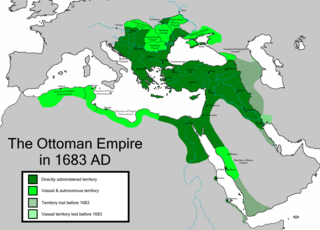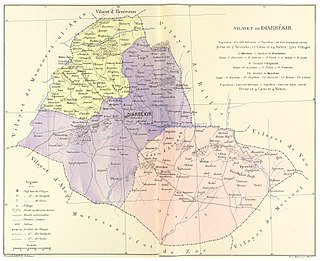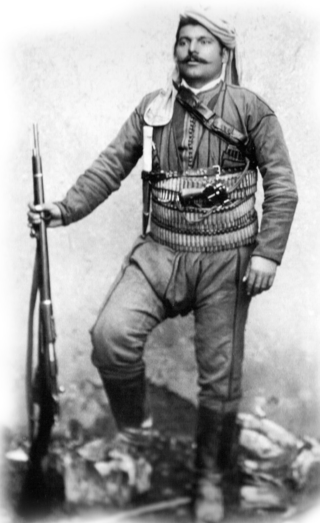Related Research Articles

Anatolia, also known as Asia Minor, is a peninsula of Turkey situated in Western Asia. It is the westernmost protrusion of the Asian continent, and constitutes the majority of contemporary territory of Turkey. Geographically, Anatolia is bounded by the Mediterranean Sea to the south, the Aegean Sea to the west, the Turkish Straits to the northwest, and the Black Sea to the north. The eastern and southeastern limits has either been expanded to the entirety of Asiatic Turkey, or to an imprecise line from the Black Sea to Gulf of Iskenderun. Topographically, the Sea of Marmara connects the Black Sea with the Aegean Sea through the Bosporus strait and the Dardanelles strait, and separates Anatolia from Thrace in the Balkan peninsula of Southeastern Europe.

The Armenian genocide was the systematic destruction of the Armenian people and identity in the Ottoman Empire during World War I. Spearheaded by the ruling Committee of Union and Progress (CUP), it was implemented primarily through the mass murder of around one million Armenians during death marches to the Syrian Desert and the forced Islamization of others, primarily women and children.

Armenian Secret Army for the Liberation of Armenia (ASALA) was a militant organization active between 1975 and the 1990s whose stated goal was "to compel the Turkish Government to acknowledge publicly its responsibility for the Armenian genocide in 1915, pay reparations, and cede territory for an Armenian homeland." ASALA itself and other sources described it as a guerilla and armed organization. Some sources, including the United States Department of State, as well as the Ministry of Foreign Affairs of Azerbaijan listed it as a terrorist organization.

The Turkish War of Independence was a series of military campaigns and a revolution waged by the Turkish National Movement, after the Ottoman Empire was occupied and partitioned following its defeat in World War I. The conflict was between the Turkish Nationalists against Allied and separatist forces over the application of Wilsonian principles, especially self-determination, in post-World War I Anatolia and eastern Thrace. The revolution concluded the collapse of the Ottoman Empire; ended of the Ottoman sultanate and Ottoman caliphate, and established the Republic of Turkey. This resulted in the transfer of sovereignty from the sultan-caliph to the nation, setting the stage for nationalist revolutionary reform in Republican Turkey.

Ottoman Turkish was the standardized register of the Turkish language in the Ottoman Empire. It borrowed extensively, in all aspects, from Arabic. It was written in the Ottoman Turkish alphabet. Ottoman Turkish was largely unintelligible to the less-educated lower-class and to rural Turks, who continued to use kaba Türkçe, which used far fewer foreign loanwords and is the basis of the modern standard. The Tanzimât era (1839–1876) saw the application of the term "Ottoman" when referring to the language ; Modern Turkish uses the same terms when referring to the language of that era. More generically, the Turkish language was called توركچه Türkçe or توركی Türkî "Turkish".

The Vilayet of Diyâr-ı Bekr was a first-level administrative division (vilayet) of the Ottoman Empire, wholly located within what is now modern Turkey. The vilayet extended south from Palu on the Euphrates to Mardin and Nusaybin on the edge of the Mesopotamian plain. After the establishment of Republic of Turkey in 1923, the region was incorporated into the newly created state.

Ottoman Armenian casualties refers to the number of deaths of Ottoman Armenians between 1914 and 1923, during which the Armenian genocide occurred. Most estimates of related Armenian deaths between 1915 and 1918 range from 600,000 to 1.2 million.

Merzifon is a town in Amasya Province in the central Black Sea region of Turkey. It is the seat of Merzifon District. Its population is 61,376 (2021). The mayor is Alp Kargı (CHP).

Musa Kâzım Karabekir was a Turkish general and politician. He was the commander of the Eastern Army of the Ottoman Empire during the Turkish War of Independence, and fought a successful military campaign against the Armenian Democratic Republic. He was the a founder and leader of the Progressive Republican Party, the Turkish Republic's first opposition party to Atatürk, though he and his party would be purged following the Sheikh Said revolt. He was rehabilitated with İsmet İnönü's ascension to the presidency in 1938 and served as Speaker of the Grand National Assembly of Turkey before his death.

The Greek genocide, which included the Pontic genocide, was the systematic killing of the Christian Ottoman Greek population of Anatolia, which was carried out mainly during World War I and its aftermath (1914–1922) – including the Turkish War of Independence (1919–1923) – on the basis of their religion and ethnicity. It was perpetrated by the government of the Ottoman Empire led by the Three Pashas and by the Government of the Grand National Assembly led by Mustafa Kemal Atatürk, against the indigenous Greek population of the Empire. The genocide included massacres, forced deportations involving death marches through the Syrian Desert, expulsions, summary executions, and the destruction of Eastern Orthodox cultural, historical, and religious monuments. Several hundred thousand Ottoman Greeks died during this period. Most of the refugees and survivors fled to Greece. Some, especially those in Eastern provinces, took refuge in the neighbouring Russian Empire.
Turkification, Turkization, or Turkicization describes a shift whereby populations or places receive or adopt Turkic attributes such as culture, language, history, or ethnicity. However, often this term is more narrowly applied to mean specifically Turkish rather than merely Turkic, meaning that it refers more frequently to the Ottoman Empire's policies or the Turkish nationalist policies of the Republic of Turkey toward ethnic minorities in Turkey. As the Turkic states developed and grew, there were many instances of this cultural shift.
The Ottoman Turkish alphabet is a version of the Perso-Arabic script used to write Ottoman Turkish until 1928, when it was replaced by the Latin-based modern Turkish alphabet.

The Partition of the Ottoman Empire was a geopolitical event that occurred after World War I and the occupation of Constantinople by British, French, and Italian troops in November 1918. The partitioning was planned in several agreements made by the Allied Powers early in the course of World War I, notably the Sykes–Picot Agreement, after the Ottoman Empire had joined Germany to form the Ottoman–German alliance. The huge conglomeration of territories and peoples that formerly comprised the Ottoman Empire was divided into several new states. The Ottoman Empire had been the leading Islamic state in geopolitical, cultural, and ideological terms. The partitioning of the Ottoman Empire after the war led to the domination of the Middle East by Western powers such as Britain and France, and saw the creation of the modern Arab world and the Republic of Turkey. Resistance to the influence of these powers came from the Turkish National Movement but did not become widespread in the other post-Ottoman states until the period of rapid decolonization after World War II.

The Anatolia College in Merzifon or American College of Mersovan was a 4-year college, high school, theological seminary, orphanage and hospital located in the town of Merzifon in the Sivas Vilayet of the Ottoman Empire. Classes were offered to both male and female students. Established by American missionaries, the college existed from 1886 to 1924. The college was essentially destroyed by the Armenian genocide in 1915. Closed until 1919, it was subsequently relocated to Thessaloniki, Greece, and still operates as Anatolia College.

The Eastern Anatolia Region is a geographical region of Turkey. The most populous province in the region is Van Province. Other populous provinces are Malatya, Erzurum and Elazığ.

Murad of Sebastia was a well-known Armenian fedayee during the Armenian national liberation movement in the Ottoman Empire. He was born in the Armenian village of Govdun (Կովտուն), about 20 km east of the town of Sivas to a poor rural family that had recently moved to the village. After working as a shepherd and farm labourer during his childhood, he moved as a teenager to Constantinople, where he worked for meagre earnings as a carrier. He joined the Social Democrat Hunchakian Party and, in the 1890s, participated in Armenian demonstrations protesting against the second-class treatment of Armenians within the Ottoman Empire.

Armenian genocide survivors were Armenians in the Ottoman Empire who survived the genocide of 1915. After the end of World War I, many tried to return home to the Ottoman rump state, which later became Turkey. The Turkish nationalist movement saw the return of Armenian survivors as a mortal threat to its nationalist ambitions and the interests of its supporters. The return of survivors was therefore impossible in most of Anatolia and thousands of Armenians who tried were murdered. Nearly 100,000 Armenians were massacred in Transcaucasia during the Turkish invasion of Armenia and another 100,000 fled from Cilicia during the French withdrawal. By 1923, about 295,000 Armenians ended up in the Soviet Union, mainly Soviet Armenia; an estimated 200,000 settled in the Middle East, forming a new wave of the Armenian diaspora; and about 100,000 Armenians lived in Constantinople and another 200,000 lived in the Turkish provinces, largely women and children who had been forcibly converted. Though Armenians in Constantinople faced discrimination, they were allowed to maintain their cultural identity, unlike those elsewhere in Turkey who continued to face forced Islamization and kidnapping of girls after 1923. Between 1922 and 1929, the Turkish authorities eliminated surviving Armenians from southern Turkey, expelling thousands to French-mandate Syria.
Hakobyan is an Armenian surname with the meaning "son of Hakob". This surname has multitudes of transliterations into Latin alphabet, including Acopian, Acopyan, Agopian, Agopyan, Akobian, Akobyan, Akopyan, Hagopian, Hagopyan, Hakobian, and others. A Russified version of this surname is Akopov. A variant is Hakobyants, Hagopiantz, with similar variations of rendering in the Latin alphabet.

George Edward White was an American Congregationalist missionary for the American Board of Commissioners for Foreign Missions for forty-three years. Stationed in the Ottoman Empire during the Armenian genocide as President of the Anatolia College in Merzifon, White attempted to save the lives of many Armenians, including "refused to tell" where Armenians were hiding so to save them from getting deported or killed. Thus he became an important witness to the Armenian Genocide.
References
- ↑ Marsoobian, Armen T. (2015). Fragments of a Lost Homeland: Remembering Armenia. London: I. B. Taurus. p. 229. ISBN 9781784532116.